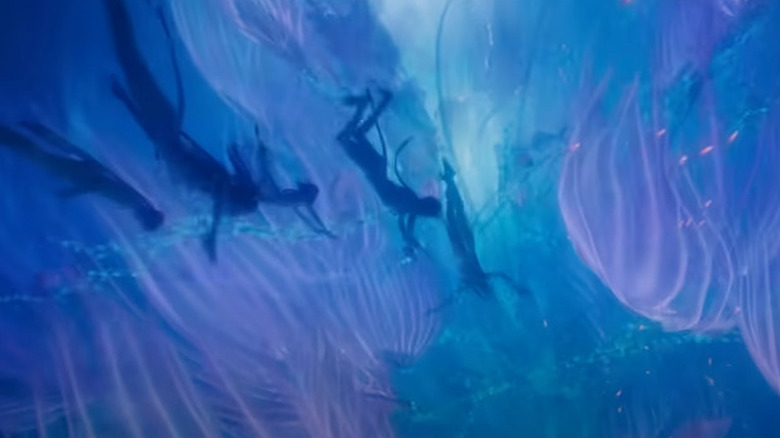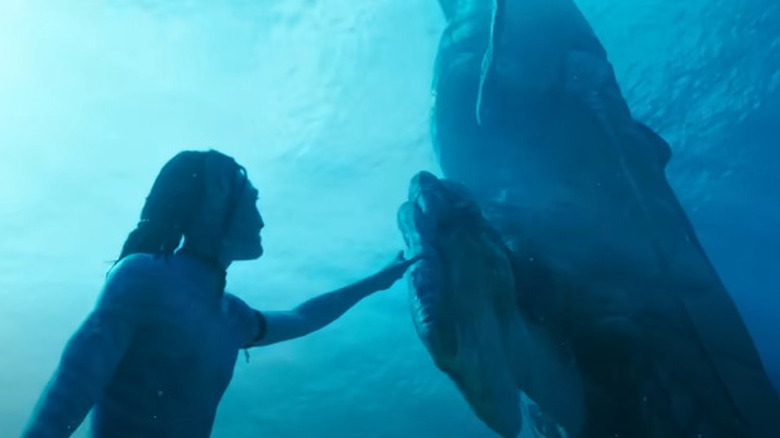James Cameron Does A Deep Dive Into The Relationship Between Avatar 2's Na'vi And Tulkun
If there were anything fans of James Cameron's "Avatar" were understandably expecting from its long-awaited sequel, it had to be the kind of intricate world-building that made the first movie such a massive box-office smash. Cameron is no stranger to the craft of world-building, implementing it in so many iconic sci-fi and fantasy works, from the cyberpunk-lite time traveling of the first two "Terminator" films to mapping out the class stratification of a luxury steamliner in "Titanic."
"Avatar: The Way of Water" seems to have made this challenge a bit more unique. If, as the guide to the craft at Studio Binder informs us, world-building is a key part of informing the decisions a protagonist and other characters make, then one of Cameron's tasks has been to look for opportunities to illustrate how delicately and intricately the ecology of Pandora is interwoven. Granted, he had the first movie to work with, but in moving the action from the rainforest to the ocean, Cameron had to further build out his world in a way that meshed with the first part, but also gave us something new.
Evolution
Speaking with National Geographic, James Cameron gave an overview of how the ecosystem of Pandora's oceans works, the difference between the rainforest-dwelling Na'vi of the first film and the Metkayina of "The Way of Water," and how their symbiotic relationship with their environment might differ from their land-bound cousins.
"We have these people called the Metkayina, a clan that's spread out across a large number of villages," said Cameron. "The Metkayina are a kind of a regional, Indigenous culture: They diverged from the land-based forest Na'vi probably tens of thousands of years ago and have physically adapted more to the ocean." Cameron also pointed out an important difference in the physiology of the Metkayina: their tails are used more for propulsion through the water.
That said, the Metkayina are still, like the Na'vi, air breathers. This means that they have developed the ability to hold their breath for very long periods of time underwater. They also have nictitating membranes, the clear "third eyelid" that protects their eyes as they swim or ride underwater at high speeds, not unlike a crocodile (via ScienceDirect). What seems most relevant to Cameron, however, is that they have a deep interconnection with one of the other key species in "The Way of Water."
The Metkayina and the tulkun
We are introduced to the tulkun not long after Jake Sully (Sam Worthington) and his family have joined the Matkayina, when his son Lo'ak (Britain Dalton) is rescued by one, named Payakan. Whale-like in appearance, they are also air-breathers. "But, of course, it's not a whale," said Cameron, "It's the Pandora version, which is called a tulkun."
Cameron also pointed out that they are highly intelligent and that they have a developed society with language, mathematics, and music. However, their advancements are all in terms of intelligence. Like the whales we recognize on Earth, they have no hands and no opposable thumbs. "They have no technology because they have no manipulating hands as we do," Cameron said. "They rely on the Na'vi for anything that requires that kind of physical manipulation."
As we also discover in "The Way of Water," the tulkun are among the many natural resources that the invading humans are looking to decimate, essentially hunting them for an enzyme in their brains that supposedly has anti-aging properties. But even though the tulkun are, obviously, quite different from the whales we know on Earth, Cameron pointed out that they are more alike than we might think.
While working on the National Geographic limited series "Secrets of the Whales," Cameron learned that all cetaceans — the order of aquatic mammals that includes all whales, porpoises, and dolphins — do indeed have a more complex culture than we previously thought. This includes the passage of information through different noises and sounds. "They have complex music that's adopted by other members of the population of that species," said Cameron, "And it travels around the world like a kind of greatest hits album."


